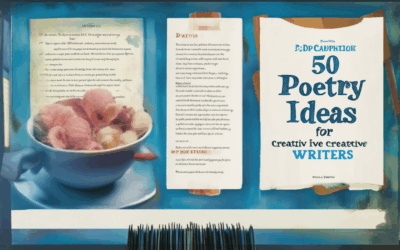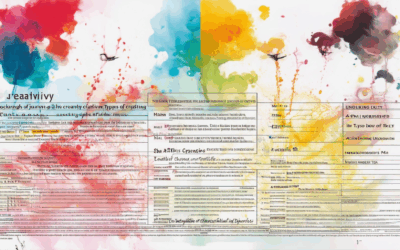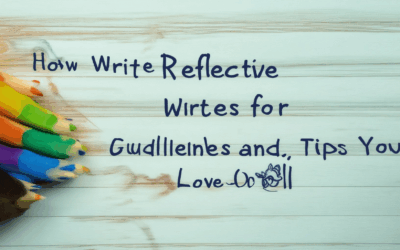Writing inspiration for beginners can be both exciting and overwhelming. Whether you’re just starting out or looking to reignite your creativity, finding the right tools and mindset is crucial. This guide explores practical tips and strategies to overcome writer’s block, discover unique angles, and craft compelling stories. By delving into personal interests, leveraging resources, and learning from successful authors, you’ll gain the confidence and skills needed to excel in your writing journey. From mastering writing prompts to avoiding clichés, this article provides a roadmap for success, ensuring you find inspiration and improve your craft along the way.
Key Takeaways
- Spark Creativity: Ignite inspiration with techniques tailored for all skill levels in writing.
- Engage Readers: Capture attention from the first word with compelling hooks.
- Set the Tone: Use strong verbs and sensory details to craft vivid scenes.
- Clarity and Flow: Create clear, concise introductions backed by thesis statements.
- Imagery Wins: Elevate writing with metaphors and sensory-rich descriptions.
- Avoid Mistakes: Simplify language, sidestep clichés, and refine for polished outcomes.
- Experiment and Grow: Explore varied forms to develop a unique writing voice.
- Inspire and Share: Embrace the writing journey and motivate storytelling.

How Can a Beginner Start Writing?
Starting to write can feel overwhelming, but with the right approach, anyone can develop their skills and find success. Here’s a step-by-step guide to help beginners get started:
1. Find Your Inspiration
Reading great works and exploring different genres can spark your creativity. Visit Silken Drum to discover inspiring articles and connect with fellow writers.
- Read widely across various genres and styles.
- Join writing groups or clubs to meet fellow enthusiasts.
- Explore writing prompts and challenges to overcome writer’s block.
2. Set Clear Goals
Having objectives helps you stay focused and motivated. Whether it’s journaling daily or aiming to complete a short story, clear goals keep you on track.
- Start small with a daily writing routine, even if it’s just 15 minutes a day.
- Set achievable milestones, like completing a poem or essay each week.
- Track your progress to celebrate your achievements and identify areas for growth.
3. Develop Your Skills
Becoming a better writer takes practice and learning. Utilize resources to improve your craft and experiment with different techniques.
- Take online writing courses or workshops offered by Silken Drum .
- Study the works of successful authors to learn their methods and style.
- Practice writing regularly to build muscle memory and improve fluency.
4. Build a Regular Writing Habit
Consistency is key to becoming a skilled writer. Establishing a routine can help you overcome distractions and develop a strong work ethic.
- Choose a quiet, distraction-free space to write.
- Set a fixed schedule, whether it’s mornings or evenings, to dedicate time to writing.
- Use tools like timers or alarms to stay on track during your writing sessions.
5. Seek Feedback and Improve
Writing is a solitary journey, but sharing your work with others can provide valuable insights and encouragement. Get constructive criticism to refine your craft.
- Share your pieces with friends, family, or writing groups for feedback.
- Join online communities like Silken Drum to connect with supportive peers.
- Be open to criticism and use it as an opportunity to grow.
6. Stay Motivated and Persistent
Writing requires dedication, and it’s normal to face challenges along the way. Keep pushing forward and remind yourself why you started.
- Keep a journal of your progress and accomplishments to boost morale.
- Set personal milestones and celebrate each achievement, no matter how small.
- Stay inspired by revisiting your initial motivation and passion for writing.
Remember, every writer starts somewhere, and with persistence, you’ll develop your unique voice and storytelling abilities. Happy writing!
How to Find Inspiration for Writing
Inspiration for writing can come from various sources, and discovering it often requires exploration and dedication. Here are some effective strategies to help you find your muse:
- Read Widely and Diversely : Immerse yourself in different genres and styles. Read books from various cultures, historical periods, and literary movements. This exposure broadens your perspective and sparks creativity.
- Set Personal Writing Challenges : Commit to writing every day for a set number of words or pages. This routine can keep your momentum going and help you overcome writer’s block.
- Experiment with Different Genres : Step out of your comfort zone and explore genres you haven’t tried before. Whether it’s fantasy, romance, or mystery, each genre offers unique storytelling techniques and approaches.
- Use Writing Prompts : Writing prompts are excellent tools to overcome writer’s block. They provide a starting point and can guide you toward discovering your own ideas.
- Keep a Writing Journal : Document your thoughts, observations, and ideas in a journal. This practice enhances your observational skills and provides material for future writing projects.
- Engage with the Writing Community : Join online forums, writing groups, or workshops to connect with fellow writers. Sharing ideas and receiving feedback can reignite your passion and provide new directions.
- Define and Adjust Your Goals : Set achievable writing goals that align with your interests and aspirations. Adjust these goals as you grow and evolve as a writer.
- Explore Cultures and Histories : Delve into literature from different cultures and historical contexts. This exploration can offer fresh perspectives and inspire unique story ideas.
- Learn from Successful Writers : Study the techniques of renowned authors through workshops, interviews, or analytical books. Their insights can provide valuable lessons for your own writing.
- Stay Curious and Explore New Experiences : Keep your curiosity alive by exploring new places, hobbies, and activities. These experiences can fuel your creativity and provide rich material for your writing.
- Embrace Failure and Rejection : Understand that rejection is a normal part of the writing process. Embrace it as a stepping stone to growth and improvement.
By combining these strategies, you can cultivate a robust creative practice that thrives on curiosity, exploration, and resilience. Remember, writing is a journey, and each step forward, no matter how small, is a victory.

What to Write About When You Have No Ideas
If you’re staring at a blank page and feeling completely stuck, don’t worry—you’re not alone. Everyone experiences writer’s block at some point. Here are some strategies to help you overcome it and find inspiration:
- Explore Your Interests : Write about something you’re genuinely curious about. Whether it’s a hobby, a passion, or a skill you want to learn, your enthusiasm will shine through.
- Break Down the Task : Don’t overwhelm yourself with grand aspirations. Start with a small, manageable task, like writing just one paragraph or outlining your main points.
- Set Realistic Goals : Set a daily word count or time limit to avoid feeling overwhelmed. Consistency is key, even if you’re not producing perfect content.
- Understand Your Audience : Consider who your readers are and what they might find valuable. Tailoring your content to their interests can make the writing process smoother.
- Seek Inspiration : Read articles, watch videos, or listen to podcasts on topics you enjoy. Exposure to diverse content can spark new ideas and perspectives.
- Experiment with Formats : Try different writing styles or formats, such as journaling, poetry, or scripting. This can help you discover what works best for you.
- Reflect on Past Successes : Recall a time when you wrote something you were proud of. Remind yourself of your strengths and achievements to build confidence.
- Take Regular Breaks : Step away from your work periodically to refresh your mind. A short walk or a quick stretch can reignite your creativity.
- Engage with Communities : Join forums, groups, or social media platforms where people discuss similar interests. Interaction with others can provide fresh insights and motivation.
- Practice Mindfulness : Techniques like meditation or deep breathing can help clear mental clutter and improve focus, making it easier to generate ideas.
- Use Tools and Resources : Experiment with writing tools like mind maps or outlines to organize your thoughts more effectively.
Remember, the key is to keep moving forward. Even if your initial ideas aren’t perfect, they can be refined and developed over time. With persistence and the right strategies, you’ll overcome writer’s block and find your creative flow.

Good Starters for Writing
Writing is a journey that begins with a spark of inspiration and evolves through careful thought and creativity. A strong opener sets the tone for your piece, grabbing the reader’s attention and guiding them through your narrative. Here are some effective strategies to craft compelling beginnings:
- Start with a Hook:** Begin with a question, a surprising fact, or a vivid scene to immediately engage the reader. For example, “Have you ever wondered why stories capture our imagination?” or “Imagine a world where…”
- Set the Scene:** Paint a mental picture with descriptive language. “On a crisp autumn morning, the scent of freshly baked bread wafted through the village square.” This invites the reader to visualize the setting.
- Tell a Story Within a Story:** Open with a brief anecdote or mini-story to introduce your theme. “Once upon a time, in a small coastal town, a young girl discovered a hidden beach…” This hooks the reader and introduces your subject matter.
- Pose a Problem or Question:** “How can we overcome the challenges of climate change?” or “What makes a relationship last?” This approach encourages the reader to delve into the content.
- Use a Quote or Reference:** “As Shakespeare said, ‘All the world’s a stage.'” Incorporating a relevant quote adds authority and insight to your opener.
Crafting a Strong Introduction
Your introduction should clearly state the purpose of your writing and hook the reader. Consider these tips:
- State Your Purpose Clearly:** Whether it’s an essay, story, or blog post, define your objective upfront. “This essay explores the impact of social media on mental health.”
- Be Concise:** Avoid lengthy introductions. Get straight to the point. “In 1939, Ernest Hemingway wrote…” leads directly into your subject.
- Use a Thesis Statement:** For academic writing, end your introduction with a thesis that outlines your argument. “This paper argues that renewable energy is essential for combating climate change.”
Using Imagery and Metaphors
Imagery enlivens your writing and makes abstract concepts tangible. Use metaphors to illustrate complex ideas:
- Compare and Contrast:** “Like a river meandering through a canyon, progress often moves forward with twists and turns.” This metaphor clarifies your meaning and engages the reader.
- Become a Visualizer:** “Picture yourself standing at the edge of a cliff. The wind whispers through the grass below, urging you to take the leap.” This vivid description draws the reader in.
Avoiding Common Mistakes
Sometimes, even the best writers stumble. Here’s how to avoid pitfalls:
- Don’t Overcomplicate:** Keep your language simple and direct. “The sun sets slowly, painting the sky in hues of orange and pink.” is clearer than “The solar orb descends gradually, its chromatic spectrum illuminating the heavens.”
- Steer Clear of Clichés:** Avoid overused phrases like “once upon a time” or “beauty is in the eye of the beholder.” Original expressions capture attention better.
- Proofread:** Editing is crucial. “Your writing reflects your thoughts, so let it shine by eliminating typos and grammatical errors.”
Experiment with Forms
Whether you’re writing fiction, poetry, or a business report, try different structures to find your unique voice:
- Free Write:** Let your thoughts flow freely without worrying about structure. “Sometimes, the best ideas come when you just let go and write.”
- Use Outlining:** For organized pieces, create a blueprint before writing. “List your main points and flesh them out one by one.”
- Read Aloud:** Hearing your words can reveal areas that need refinement. “Reading your work aloud helps catch rhythm and flow issues.”
Conclusion
Remember, writing is a process. Start with a solid foundation, and let your creativity guide you. At Silken Drum, we celebrate every word, encouraging you to share your stories and inspire others. Join us today and discover the power of words!
Explore Silken Drum
What is a good opening sentence for creative writing?
A great opening sentence for creative writing should immediately grab the reader’s attention while setting the tone or introducing a central element of the story. Here are some strategies and examples:
- Use a strong verb:** Start with an action that disrupts the ordinary, like “The room fell silent as the stranger walked in.” This creates intrigue and sets a dramatic scene.
- Sensory details:** Engage the reader’s senses with descriptions like “The scent of rain filled the air as he approached the old house,” drawing them deeper into the narrative.
- Unexpected twist:** Begin with an event that challenges expectations, such as “The envelope arrived with just the sound of leaves rustling in the breeze,” hinting at a mysterious journey ahead.
- Internal thoughts:** Offer a glimpse into a character’s mind, such as “She noticed the faint ticking of the clock as she realized her life was changing,” adding emotional depth.
- Conflict or mystery:** Pose a question or dilemma, like “The mirror showed her reflection, but she didn’t recognize her own face,” sparking curiosity and suspense.
- Metaphors or similes:** Paint a vivid picture with comparisons, such as “The city was alive with the hum of secrets waiting to be told,” evoking a sense of intrigue.
- Action leading to consequence:** Show cause and effect, like “The knock on the door shattered the quiet of the night, changing everything,” immediately grabbing attention.
- Moment of realization:** Reveal a crucial understanding, such as “He finally understood the truth when the pieces fell into place,” leaving the reader eager to uncover more.
By blending strong verbs, sensory details, and elements of surprise or introspection, you can craft an opening sentence that hooks readers and invites them to explore your story further. Whether it’s a simple yet powerful statement or a complex setup, the key is to captivate the audience from the very first word.

The Four Basics of Good Writing
Good writing is essential for effectively communicating ideas and engaging audiences. Here are the four fundamental principles that every writer should master:
1. Clarity and Simplicity
Writing should be easy to understand. Use clear language and avoid unnecessary jargon. Break complex ideas into digestible parts. The goal is to convey meaning quickly and efficiently.
2. Consistency and Coherence
Consistency ensures that your writing flows smoothly. Maintain a consistent tone, style, and structure throughout your content. Coherence helps readers follow your narrative or argument without getting lost.
3. Voice and Tone
Your writing’s voice and tone shape its personality. Choose a tone that aligns with your audience and purpose. Whether formal or casual, stay authentic to your intended message.
4. Relevance and Context
Everything you write should relate to your central theme or purpose. Provide context to help readers connect with your content and understand its significance.
To enhance your writing skills, explore Silken Drum’s resources and community-driven discussions. Fostering creativity and reflection, we inspire writers to appreciate the power of the written word.
For more tips and tools to improve your writing, visit our Silken Drum homepage .




0 Comments